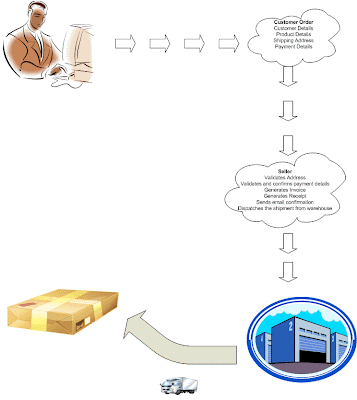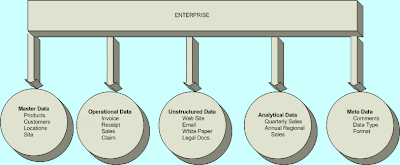1. End customer logs in to online shopping portal.
2. Selects and configure the right product.
3. Initiate checkout process
- Provides shipping address.
- Provide payment details.
- Confirm the order.
The entire process involves data flow from one point to another and finally halts with shipment of product. Product,customer,location etc represents real world objects but information about order,invoice,receipt which are shared between two points in electronic format are transactional in nature and represents virtual objects. A pictorial representation and data captured in the online shopping is below :

In essence data for any enterprise can be classified in following major categories :
Non Transactional(Master Data) Data :
Non transactional data represents critical nouns for any business and generally provides information about person,location,things and concepts. Non transactional data are very common classification of data which exists across all industries Retail,Manufacturing,Engineering,Oil,Pharmaceutical etc.
Transactional Data :
Transactional data is related to sales,invoice,receipt,claim etc. and other monetary and non monetary interactions.
Data About Data (Metadata) :
This is data about another data and contains details like data type(character,number,date etc ..), comments about data etc. and are generally maintained in some kind of repository.
Unstructured Data :
This is data found in various formats floating or maintained in variuos formats like email,website.white paper, legal and marketing collateral etc.
Analytical Data
As the word 'Analytical' suggestes , it assists company's decission making. Analytical data comprises of various forms of data assembled into a one giant data warehouse or multiple data marts to help enterprise make wise and intelligent decission which might impact the sale, reduce cost, identify latency in supply chain.

Really you have done a good job. Thanks for sharing this valuable information....
ReplyDeleteInformatica MDM Training in Chennai
Informatica Training in Chennai
Informatica Training in Bangalore
This post is so interactive and informative.keep update more information...
ReplyDeleteselenium training in mumbai
selenium training in kolkata
selenium course in kochi
selenium training in ahmedabad
selenium training in trivandram
Well-written informational piece. Thank you for sharing.
ReplyDeleteApi Testing institute in Hyderabad